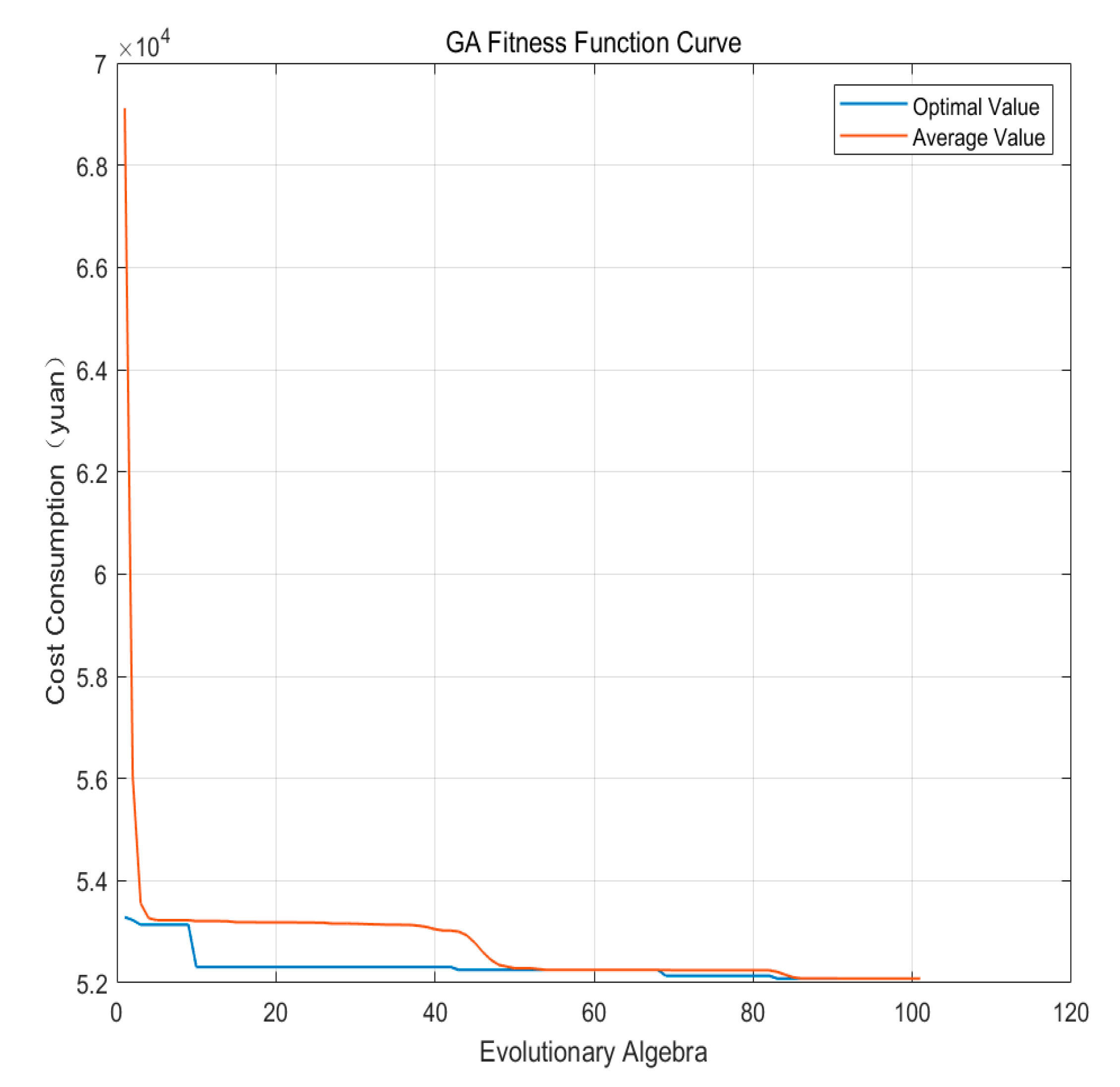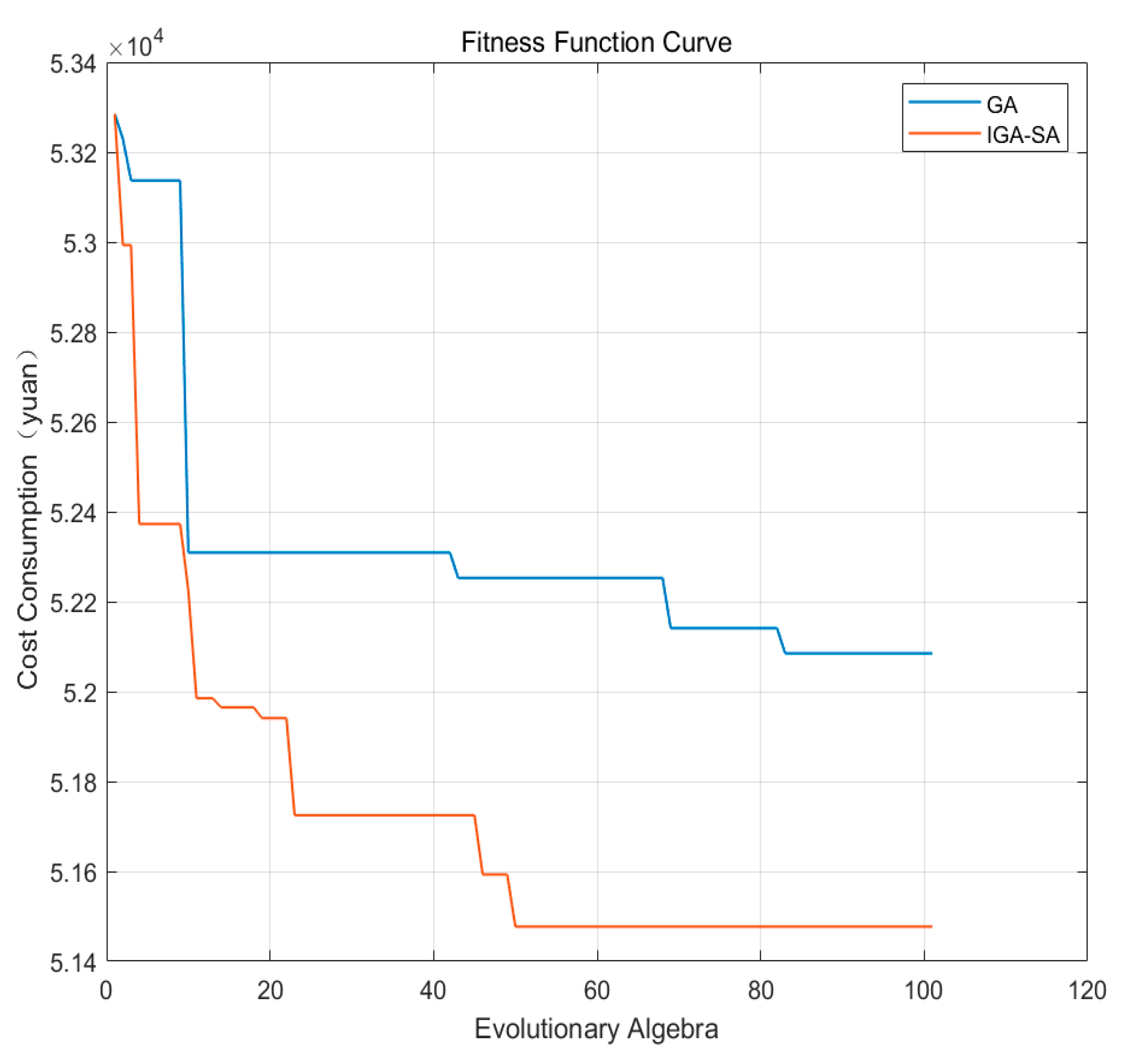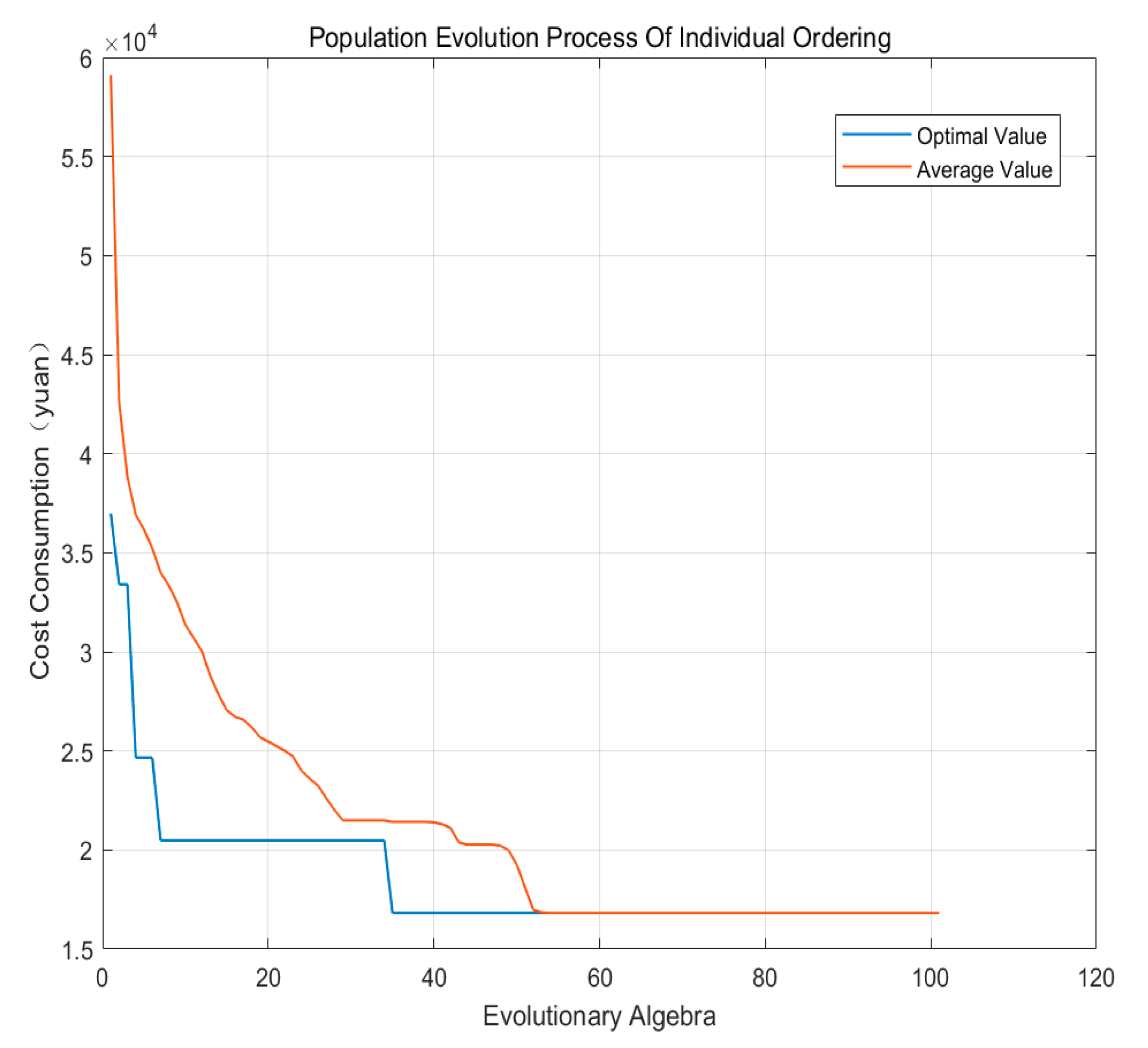Optimization of Ordering and Allocation Scheme for Distributed Material Warehouse Based on IGA-SA Algorithm
Abstract
:1. Introduction
- (1)
- The ordering and transfer cost model of material distributed system considering random material demand, lead time of ordering center and discount of ordering is established. Compared with the previous models, this model is more in line with the actual management requirements
- (2)
- The improved algorithm based on genetic and simulated annealing is adopted, and IGA-SA algorithm is used to solve the best material ordering scheme and distribution scheme.
- (3)
- The programming solution simulates a real example to verify the effectiveness of the proposed algorithm in this paper, obtains the optimal configuration scheme, and compares the proposed method with the traditional one, proving that the proposed method is superior to the traditional one.
2. Establishment and Analysis of Cost Model
2.1. Conditional Hypothesis
- (1)
- This material distributed system uses the method of regularly checking the inventory of each storage point, unifying the ordering, and using the (R, Q) ordering strategy [13], that is, each storage point continuously checks its material inventory. When the total material inventory level of all storage points is lower than the ordering point R, the material coordination centre issues the ordering request to the ordering centre, and orders the materials of Q units.
- (2)
- Supposing that the material demand Dit of any storage point i () obeys the normal distribution [14], and the material demand of each storage point every day is independent. Therefore, in t (unit: day) days, the material demand Dit of the ith storage point obeys the normal distribution .
2.2. Variable Provision
2.3. Ordering Cost Model
2.4. Allocation Cost Model
2.5. Analysis of Cost Model
3. Improvement of the Genetic Simulated Annealing Algorithm
3.1. Improved Adaptive Crossover and Mutation Probability
3.2. Improved Fusion Metropolis Criterion
- (1)
- Define the new solution acceptance probability P:In this formula, k is Boltzmann constant, is a fitness function value of the individual in new species group, and is a fitness function value of the individual in geriatric populations.
- (2)
- When the individual fitness function value in the new solution is larger than that in the old solution, the new individual is accepted as the basis of the next iteration.
- (3)
- When the individual fitness function value in the new solution is less than that in the old solution, the gene of the new individual will be interchanged with the gene of other positions with a probability of 0.01. The individual in the new solution will be accepted with a probability of P, and the other individuals in the old solution will be accepted.
4. Numerical Example
4.1. Example Description
4.2. Solution and Analysis of the Ordering Process
4.3. Solution and Analysis of Allocation Process
5. Discussion
6. Conclusions
Author Contributions
Funding
Acknowledgments
Conflicts of Interest
References
- Xia, Z.W. Research on the Modelling Method of Compact Aviation Material Storage System under the Distributed System; Civil Aviation University of China: Beijing, China, 2014. [Google Scholar]
- Xu, H.B.; Sun, X.M.; Wang, D.; Zhou, J.H.; Zhang, G.C. Storage technology in distributed inventory system. Hoisting Transp. Mach. 2003, 11, 10–12. [Google Scholar]
- Herer, Y.T.; Tzur, M.; Ycesan, E. The multi-location transhipment problem. IIE Trans. 2006, 38, 185–200. [Google Scholar] [CrossRef]
- Lv, R.; Sun, L.F. An overall scheme and a software tool of coordination and control of accessories stock for cloud service platform of industrial chain. Comput. Eng. Sci. 2017, 39, 1812–1818. [Google Scholar]
- Li, J.F. Research on distributed inventory system based on system dynamics. Digit. Technol. Appl. 2016, 10, 249. [Google Scholar]
- Zeng, L.M.; Han, R.Z. Discussion and Simulation of distributed inventory system strategy. J. Syst. Simul. 2010, 22, 2528–2531. [Google Scholar]
- Liu, Y.C.; Chen, Q.X.; Mao, N. The distributed inventory control strategy of mould franchise chain manufacturing system. Comput. Integr. Manuf. Syst. 2006, 12, 1887–1893. [Google Scholar]
- Chen, P.L. Research on the application of web services-based distributed spare parts inventory allocation system. J. Wuhan Univ. Sci. Technol. (Transp. Sci. Eng. Ed.) 2003, 27, 303–305. [Google Scholar]
- Chakraborty, D.; Bhuiy, S.K. A continuous review inventory model with fuzzy service level constraint and fuzzy random variable parameters. Int. J. Appl. Comput. Math. 2016, 3, 3159–3174. [Google Scholar] [CrossRef]
- Wanke, P.; Ewbank, H.; Leiva, V.; Rojas, F. Inventory management for new products with triangularly distributed demand and lead-time. Comput. Oper. Res. 2016, 69, 97–108. [Google Scholar] [CrossRef]
- Dada, M.; Xu, Y.; Bisi, A. New structural properties of inventory models with poly frequency distributed demand and fixed setup cost. J. Ind. Manag. Optim. 2017, 13, 931. [Google Scholar]
- Jia, C.L. Research on multi-level inventory cost control model and algorithm in supply chain. Chin. J. Manag. Sci. 2015, 23, 116–122. [Google Scholar]
- Tamjidzad, S.; Mirmohammadi, S.H. Optimal (r, Q) policy in a stochastic inventory system with limited resource under incremental quantity discount. Comput. Ind. Eng. 2017, 103, 59–69. [Google Scholar] [CrossRef]
- Khan, W.F.; Dey, O. Continuous review inventory model with normally distributed fuzzy random variable demand. Int. J. Appl. Comput. Math. 2018, 4, 1–18. [Google Scholar] [CrossRef]
- Chen, R.Q.; Ma, S.H. Production and Operation Management; Higher Education Press: Beijing, China, 1999; pp. 156–172. [Google Scholar]
- Zhang, S.H.; Chen, X.D.; Chen, X. Research on ordering strategy of a distribution system based on adaptive genetic algorithm. Comput. Eng. Appl. 2003, 24, 212–214. [Google Scholar]
- Wang, Z.; Wang, B.; Liu, C.; Wang, W.S. Improved BP neural network algorithm to wind power forecast. J. Eng. 2017, 13, 940–943. [Google Scholar] [CrossRef]
- Gao, C.; Gao, Y.; Lv, S. Improved simulated annealing algorithm for flexible job-shop scheduling problems. In Proceedings of the Chinese Control and Decision Conference, Yinchuan, China, 28 May 2016; IEEE: Piscataway, NJ, USA; pp. 2191–2196. [Google Scholar]
- Kang, Z.; Qu, Z. Application of BP neural network optimized by genetic simulated annealing algorithm to the prediction of air quality index in Lanzhou. In Proceedings of the IEEE International Conference on Computational Intelligence and Applications, Beijing, China, 8–11 September 2017; IEEE: Piscataway, NJ, USA; pp. 155–160. [Google Scholar]
- Zhang, J.; Chung, S.H.; Lo, W.L. Clustering-based adaptive crossover and mutation probabilities for genetic algorithms. IEEE Trans. Evol. Comput. 2007, 1, 326–335. [Google Scholar] [CrossRef]
- Tian, Q.C.; Pan, Q.; Wang, F. Research on BP neural network learning algorithm based on metropolis criterion. Tech. Autom. Appl. 2003, 5, 15–17. [Google Scholar]
- Wang, L.F.; Guo, X.D.; Zeng, J.C. Particle swarm optimization algorithm based on Metropolis criterion. J. Syst. Simul. 2008, 14, 284–287. [Google Scholar]






| Variable | Variable Interpretation |
|---|---|
| Rit | Order point of storage point i in t time (unit: item) |
| Qit | The number of materials provided by the ordering centre to storage point i in t time (unit: item) |
| Qijt | The number of materials transferred from storage point i to storage point j in t time, with a negative value in the opposite direction (unit: item) |
| Dit | The normal distribution of material demand at storage point i in t time (unit: item) |
| Vimax | The maximum storage capacity of storage point I (unit: item) |
| BSi | The lead time of materials provided by the ordering centre to storage point I (unit: day) |
| FCt | The maximum material supply capacity of the ordering centre in t time (unit: item) |
| Y | The service level of the enterprise construction process, i.e., probability of sufficient supply of materials |
| BVit | Initial material inventory level of storage point i in t time (unit: item) |
| Pit(x) | The probability of material demand at storage point i in t time, f(x) is its probability density function |
| Xit | Safety material inventory of storage point i in t time (unit: item) |
| C1 | Warehouse keeping cost (unit: yuan) |
| C2 | Shortage cost when ordering materials (unit: yuan) |
| C3 | Ordering cost when ordering (unit: yuan) |
| C4 | Transportation cost when ordering (unit: yuan) |
| C5 | Other costs when ordering (unit: yuan) |
| C6 | Warehousing maintenance cost during transfer (unit: yuan) |
| C7 | Shortage cost during transfer (unit: yuan) |
| C8 | Transportation cost during transfer (unit: yuan) |
| C9 | Other costs during transfer (unit: yuan) |
| CFit | Unit material ordering fee when warehouse i orders materials from the ordering centre (unit: yuan/time) |
| CIi | Cost of material input to storage point i (unit: yuan) |
| COi | Cost of outbound materials at storage point i (unit: yuan) |
| CMit | Handling cost of each order of storage point i within t time (unit: yuan/time) |
| CAit | The processing cost of each allocation of storage point i within t time (unit: yuan/time) |
| CPit | The labour cost of storage point i at each time of ordering in t time (unit: yuan/time) |
| CWit | Storage cost per unit of materials at storage point i in time t, including cost occupied by materials, use and storage cost of storage, the storage cost of materials and other related costs (unit: yuan/item) |
| CSit | Cost of loss caused by the shortage of materials at storage point i in t time (unit: yuan/item) |
| CLit | Transportation cost per materials transportation unit distance of storage point i within t time (unit: yuan/time) |
| L0i | Distance between order centre and storage point i (unit: km) |
| Lij | Distance between storage point i and storage point j (unit: km) |
| X | Random variable |
| Z1i | The total cost of ordering materials from the ordering centre at storage point i in t time (unit: yuan) |
| Z2 | The total cost of materials ordered by the whole storage system from the ordering centre in t time (unit: yuan) |
| Z3i | The total cost of material allocation at storage point i in t time (unit: yuan) |
| Z4 | The total cost of material allocation between storage points in t time (unit: yuan) |
| Ztotal | Total cost (unit: yuan) |
| 1-y | Fencing point |
| Average daily material demand (unit: item) | |
| The standard deviation of daily demand |
(Item) | BVit (Item) | Vimax (Item) | (Item) | BSi (Day) | y (%) | t (Day) | |
|---|---|---|---|---|---|---|---|
| Storage point 1 | 10 | 17 | 200 | 1.2 | 3 | 95 | 10 |
| Storage point 2 | 12 | 22 | 220 | 1.6 | 5 | 95 | 10 |
| Storage point 3 | 7 | 30 | 280 | 1.7 | 3 | 95 | 10 |
| Storage point 4 | 16 | 25 | 240 | 2.0 | 2 | 95 | 10 |
| CFit (Yuan/Time) | CWit (Yuan/Item) | CSit (Yuan/Item) | CPit (Yuan/Time) | CIit (Yuan/Time) | COit (Yuan/Time) | |
|---|---|---|---|---|---|---|
| Storage point 1 | 200 | 24 | 76 | 300 | 200 | 150 |
| Storage point 2 | 200 | 28 | 80 | 300 | 200 | 150 |
| Storage point 3 | 200 | 19 | 69 | 300 | 200 | 150 |
| Storage point 4 | 200 | 22 | 73 | 300 | 200 | 150 |
| Ordering Quantity Q (Item) | Q < 30 | 30 ≤ Q < 80 | Q ≥ 80 |
|---|---|---|---|
| Discount price C (Yuan/item) | 40 | 35 | 30 |
| Storage Point | BVit (Item) | Ri (Item) | Qi (Item) |
|---|---|---|---|
| Storage point 1 | 17 | 34 | 63 |
| Storage point 2 | 22 | 66 | 70 |
| Storage point 3 | 30 | 26 | 26 |
| Storage point 4 | 25 | 37 | 79 |
| Total ordering quantity: 238 items | |||
| Total ordering cost: 51,477 yuan | |||
| Storage Point | Ri (Item) | Qi (Item) | Zi (Yuan) |
|---|---|---|---|
| Storage point 1 | 34 | 71 | 15,192 |
| Storage point 2 | 66 | 82 | 17,414 |
| Storage point 3 | 26 | 23 | 5,496 |
| Storage point 4 | 37 | 115 | 24,080 |
| Total ordering quantity: 291 items | |||
| Total ordering cost: 62,182 yuan | |||
| Total Ordering Quantity Q (Item) | Total Ordering Cost Ztotal (Yuan) | |
|---|---|---|
| Original ordering scheme | 291 | 62,182 |
| Improved ordering scheme | 238 | 51,477 |
| Reduction percent | 18.21% | 17.22% |
| Solving Algorithm | Iteration Times N (Time) | Ordering Cost Ztotal (Yuan) |
|---|---|---|
| GA | 83 | 52,085 |
| IGA-SA | 50 | 51,477 |
| Storage Point | Ri (Item) | BVit (Item) |
|---|---|---|
| Storage point 1 | 34 | 75 |
| Storage point 2 | 66 | 60 |
| Storage point 3 | 26 | 80 |
| Storage point 4 | 37 | 30 |
| Storage Point 2 | Storage Point 3 | Storage Point 4 | |
|---|---|---|---|
| Storage point 1 | 8 | 9 | 7 |
| Storage point 2 | / | 6 | 13 |
| Storage point 3 | / | / | 9 |
| Storage Point | Storage Point 2 | Storage Point 4 |
|---|---|---|
| Storage point 1 | 8 | 12 |
| Storage point 3 | 10 | 23 |
| Total allocation cost: 13,899.7 yuan | ||
| Storage Point 1 | Storage Point 2 | Storage Point 3 | Storage Point 4 | |
|---|---|---|---|---|
| Qi (item) | 0 | 21 | 0 | 45 |
| Total ordering cost: 16,819 yuan | ||||
© 2020 by the authors. Licensee MDPI, Basel, Switzerland. This article is an open access article distributed under the terms and conditions of the Creative Commons Attribution (CC BY) license (http://creativecommons.org/licenses/by/4.0/).
Share and Cite
Jiang, H.; Wu, Y.; Zhang, Q. Optimization of Ordering and Allocation Scheme for Distributed Material Warehouse Based on IGA-SA Algorithm. Mathematics 2020, 8, 1746. https://doi.org/10.3390/math8101746
Jiang H, Wu Y, Zhang Q. Optimization of Ordering and Allocation Scheme for Distributed Material Warehouse Based on IGA-SA Algorithm. Mathematics. 2020; 8(10):1746. https://doi.org/10.3390/math8101746
Chicago/Turabian StyleJiang, Han, Yunlong Wu, and Qing Zhang. 2020. "Optimization of Ordering and Allocation Scheme for Distributed Material Warehouse Based on IGA-SA Algorithm" Mathematics 8, no. 10: 1746. https://doi.org/10.3390/math8101746
APA StyleJiang, H., Wu, Y., & Zhang, Q. (2020). Optimization of Ordering and Allocation Scheme for Distributed Material Warehouse Based on IGA-SA Algorithm. Mathematics, 8(10), 1746. https://doi.org/10.3390/math8101746





